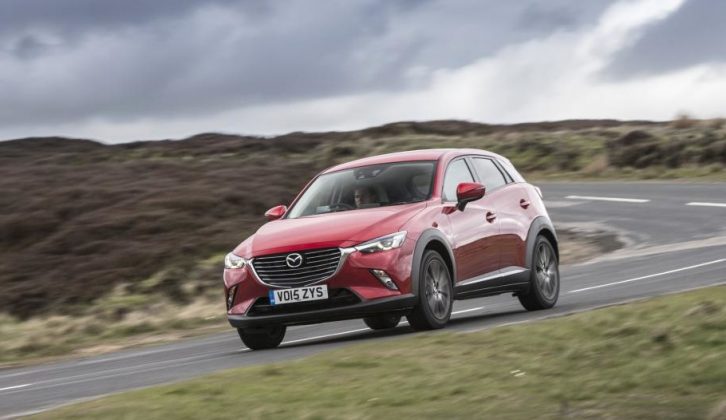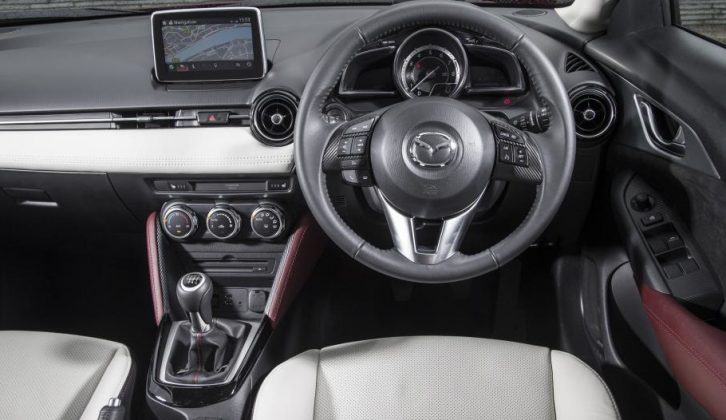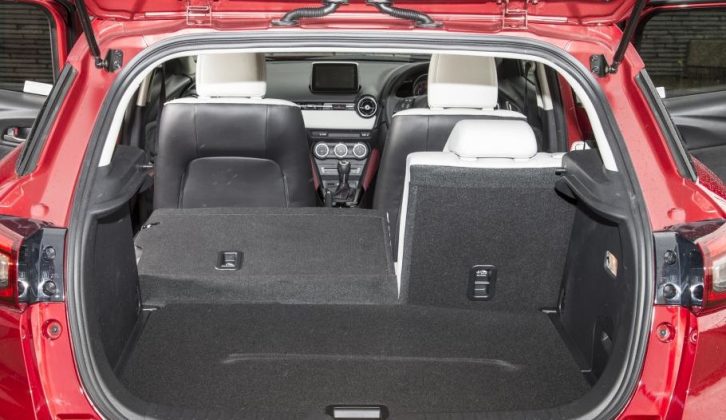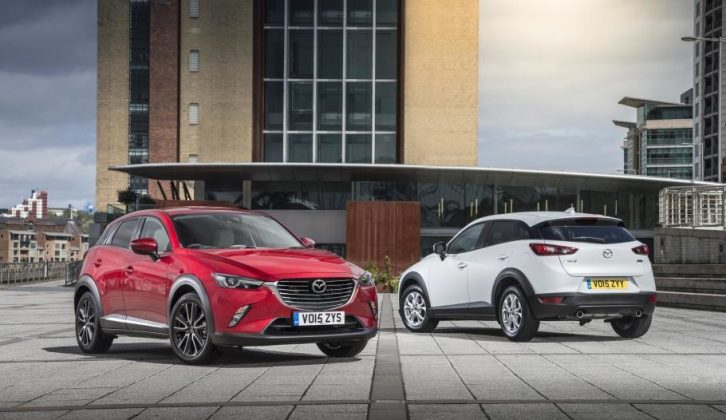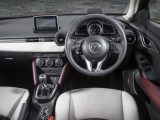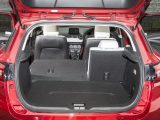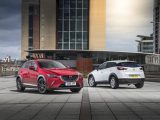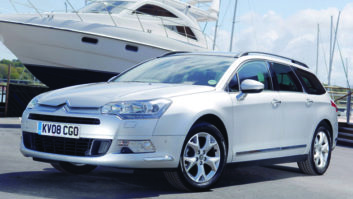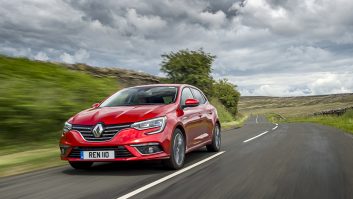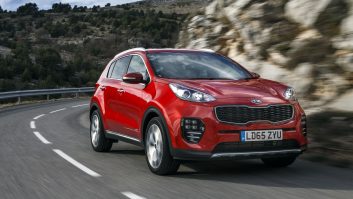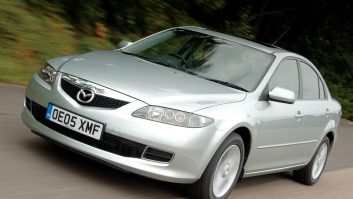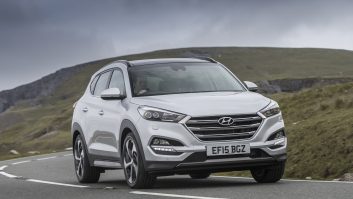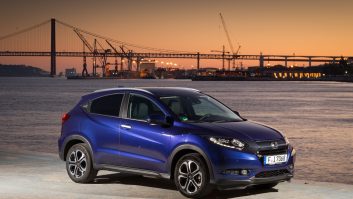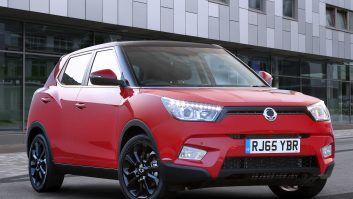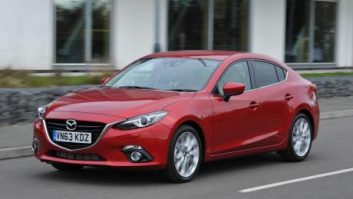Car makers are queuing up to launch compact crossovers like the new Mazda CX-3. It’s one of the fastest growing market segments, with new rivals for the likes of the Nissan Juke and Renault Captur appearing all the time. Provided you own a light enough caravan to make a suitable match, what tow car potential these rugged-looking small cars have might come as a surprise.
Having spent the past couple of days driving the CX-3 on some fabulous roads in the north of England and the Scottish Borders, the new Mazda has the makings of a solid pint-sized tow car. Kerbweights start from 1230kg for the two-wheel-drive 120PS (118bhp) petrol rising to 1370kg for the four-wheel-drive 105PS (103bhp) diesel automatic. That gives an 85% match figure of between 1046kg and 1165kg. The legal towing limit for all models is 1200kg. So, the CX-3 is only suitable for lightweight tourers and micro caravans.
Mazda expects the 120PS petrol to be the best-seller (there’s also a 150PS petrol with four-wheel drive). I can see why. For one thing, it’s £1400 cheaper than the diesel. You’ll need to drive a long way to make that back in fuel savings (the petrol returns 47.9mpg on the combined cycle, the two-wheel-drive diesel 70.6mpg). It’s also quieter than the diesel, which can sound a little strained at high revs.
There’s also a more powerful 150PS (148bhp) petrol. The extra top-end punch is noticeable, but this engine is only available in the top trim level with four-wheel drive, which makes it an expensive choice.
Both the petrol engines have reasonable mid-range pull, but if you’re really in a hurry they need to be revved hard. So despite the big price difference between the 120PS petrol and the 105PS diesel, the latter looks like a better bet for towing duties.
The diesel models are heavier than the petrol (kerbweights start from 1275kg) and the engine packs surprising punch considering it’s just a 1.5-litre. Peak torque of 199lb ft arrives at only 1600rpm and stays all the way to 2500rpm. With such a flexible engine there’s no need to work the gearbox hard, but if you do the six-speed manual ‘box has a pleasingly slick and precise action.
If you’d rather go for an auto, there is a six-speed automatic transmission available with the two-wheel-drive petrol car and the four-wheel-drive diesel. It’s a responsive gearbox, quick to change down a gear when required, and there are paddles behind the wheel so the driver can take charge.
Mazda has the knack of making cars that are fun to drive, and it’s not been lost with the CX-3. It’s a hoot to drive on twisting country roads, with pleasingly direct steering, strong reserves of grip and little lean in corners, even when driven enthusiastically. The car’s small size makes it easy to thread down narrow country lanes, and there’s no bounce or wallow over dips and crests, just firm control. It all bodes well for the CX-3’s stability when towing.
The flipside is a fairly firm ride, but it’s far from uncomfortable. However, go for the range-topping Sport Nav model, which rides on 18-inch wheels rather than the 16-inch alloys fitted to less expensive models, and you’ll feel bumps in the road more.
If there is a weakness from the driver’s seat, it’s that there’s too much road noise. The rumbling from the tyres disturbs the peace in what’s otherwise a reasonably quiet cabin.
There’s good and bad to report inside the Mazda CX-3. The interior design is crisp and modern, with a sporty steering wheel, round air vents and a seven-inch colour touchscreen fitted to all models. But the plastics are rather hard and shiny.
The driver and front seat passenger have plenty of space, but the rear seats are rather snug. The curve of the roof and upward sweep of the rear door mean there’s only a small rear window, adding to the sense of being hemmed in.
Boot space is a respectable 350 litres for SE and SE-L models, dropping to 287 litres if you choose the Sport Nav model. That’s a big difference, and it’s due to the huge Bose speaker in the boot of this model. Either way, there’s more space in the Renault Captur’s 455-litre boot.
Without the speaker, it’s possible to set the boot floor to different levels, giving one large space or dividing it in two and creating some hidden storage. Fold the rear seats down (60:40 split seats are standard on all models) and the capacity increases to 1260 litres (1197 litres for Sport Nav cars). There’s a very slight slope to the floor with the seats folded, but no step so long as the floor is set to the higher of its two levels.
Equipment is generous, but then so it should be when the CX-3 costs considerably more than most rivals. Prices start from £17,595 for petrol cars, while the cheapest diesel is £18,995. The entry-level Nissan Juke costs £13,930, and the Renault Captur starts from £14,295.
SE cars have 16-inch alloys, power-folding door mirrors, manual air conditioning, a six-speaker stereo with Bluetooth connectivity, a trip computer, front and rear electric windows and cruise control.
Extra equipment on SE-L cars includes front LED fog lights, rear parking sensors, climate control and rear-privacy glass. The list of safety kit also lengthens, with Smart City Brake Support and a Lane Departure Warning System.
Step up to Sport Nav cars for half synthetic leather, half cloth upholstery, LED headlights, an Adaptive Front Lighting System, a reversing camera, a head-up display (which puts key information like the car’s speed in the driver’s line of sight), keyless entry and satellite navigation, as well as 18-inch alloys and a Bose stereo.
That’s a lot of toys. But however well equipped it is, the CX-3 is a small car with a surprisingly big price tag. What’s more, it’s less practical than a Renault Captur or a Peugeot 2008.
Even so, I really like it. In my book it’s better to drive than any of its rivals, and that dynamic ride and handling mean the CX-3 should make a very effective small tug. Hopefully I’ll have a chance to hitch up a van and prove what tow car ability it has soon.
In my book it's better to drive than any of its rivals
